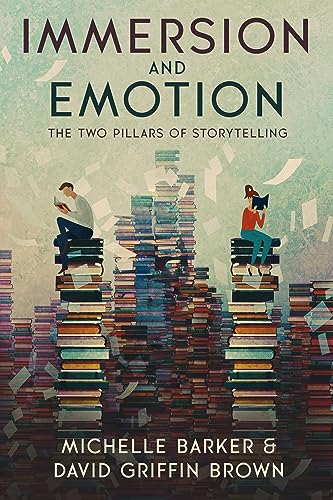
Immersion and Emotion: The Two Pillars of Storytelling

Book Broker interview series on the Chopping Blog,
Michelle Barker • Immersion and Emotion: The Two Pillars of Storytelling
Showing versus Telling: The Contradiction Truth? Something had been bothering us about this rule for years. “When you think about it,” David said to Michelle one day, “isn’t everything other than dialogue a form of telling?”
Michelle Barker • Immersion and Emotion: The Two Pillars of Storytelling
Deep third person: This POV mode is sometimes called close third or limited third.
Michelle Barker • Immersion and Emotion: The Two Pillars of Storytelling
Focus on the unique aspects of the scene, things a reader might not imagine on their own. Focus on what’s important and skip what isn’t. Don’t stop the story to provide this description. Weave it in with the character’s movements and actions so the story keeps flowing.
Michelle Barker • Immersion and Emotion: The Two Pillars of Storytelling
Here are some guidelines to consider when you’re mulling over how to turn telling into showing:
Michelle Barker • Immersion and Emotion: The Two Pillars of Storytelling
Here are some things that don’t happen on a theater stage: The actors don’t stand there and announce, “I’m feeling happy.” They don’t sit down in a room by themselves and think out loud for half an hour. They don’t stop the play to say, “Hold on. Let me summarize the history of Copenhagen,” or whatever the play happens to be about. They don’t sit
... See moreMichelle Barker • Immersion and Emotion: The Two Pillars of Storytelling
Read widely and analyze: Read different authors and genres and pay close attention to how they use voice in their work. Notice the narrative choices they make and how those choices reflect the characters’ personalities, attitudes, and emotions. How do they use language, tone, syntax, and imagery? Write down your observations and reflect on how you
... See moreMichelle Barker • Immersion and Emotion: The Two Pillars of Storytelling
How do you show instead of tell? By dramatizing. That’s what showing really is. You don’t tell your readers that Adam is jealous. You describe that sideways glare he’s giving his girlfriend. You allow him to make a snide remark. You describe the bitter taste in his mouth. The word jealous might never even appear in the passage, but your readers
... See moreMichelle Barker • Immersion and Emotion: The Two Pillars of Storytelling
You’re a dream-weaver, and the one thing you don’t want is for your dreamers (readers) to wake up. You want them to be so caught up in the dream of your fictional world, it’s as though they’re living it themselves.